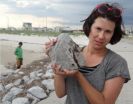(Press-News.org) EUGENE, Ore. – (July 16, 2014) – A new study by researchers at the University of Oregon published today in the journal Neuron describes a brainstem circuit in mice that may help explain how active movement impacts the way the brain processes sensory information.
"Previous studies have examined changes in the visual cortex of mice during running. What was unknown was how do running and vision get linked together in the first place?" said Cristopher Niell, a biology professor in the Institute of Neuroscience and the senior author on the paper "Identification of a Brainstem Circuit Regulating Visual Cortical State in Parallel with Locomotion."
The "aha moment" that inspired the study came five years ago when Niell, as a postdoctoral fellow in Michael Stryker's lab at the University of California, San Francisco, was examining visual perception in mice. He observed that running appeared to be changing how neurons in the brain were firing.
"We found that running turned up the magnitude in the mouse's visual cortex by about two-fold — the signals were basically twice as strong when the mouse was running," Niell said.
This initial finding, demonstrating a mind-body connection in the mouse visual system, was published in Neuron in 2010. Following up on this finding, Niell's team sought to identify neural circuits that could link movement and vision together.
The researchers focused on the brain's mesencephalic locomotor region (MLR), which has been shown to mediate running and other forms of activity in many species. They hypothesized that neural pathways originating in the MLR could serve a dual role – sending a signal down to the spinal cord to initiate locomotion, and another up to the cortex to turn up the visual response.
Using optogenetic methods, the team created genetically sensitized neurons in the MLR region of the mouse brain that could be activated by light. The team then recorded the resulting increased visual responses in the cortex. Their results demonstrated that the MLR can indeed lead to both running and increased responsiveness in the cortex, and that these two effects could be dissociated, showing that they are conveyed via separate pathways.
Next, researchers activated the terminals of the neurons' axons in the basal forebrain, a region that sends neuromodulatory projections to the visual cortex. Stimulation here also induced changes in the cortex, but without the intermediary step of running. Interestingly, the basal forebrain is known to use the neuromodulator acetycholine, which is often associated with alertness and attention.
It is unclear whether humans experience heightened visual perception while running, but the study adds to growing evidence that the processes governing active movement and sensory processing in the brain are tightly connected. Similar regions have been targeted in humans for therapeutic deep-brain stimulation to treat motor dysfunction in patients with Parkinson's disease. Activating this circuit might also provide a means to enhance neuroplasticity, the brain's capacity to rewire itself.
Niell's team included Moses Lee, a visiting scholar at the UO and student in the M.D.-Ph.D. program at UC-San Francisco, who served as the lead author on the paper. "While it seems that moving and sensing are two independent processes, a lot of new research suggests that they are deeply coupled," Lee said. "My hope is that our study can help solidify our understanding of how the brain functions differently in 'alert' states."
INFORMATION:
Other authors were Jennifer Hoy of the UO, Antonello Bonci of the National Institute of Drug Abuse and Johns Hopkins School of Medicine, Linda Wilbrecht of the UC-Berkeley, and Stryker. Research in the Niell lab at the UO was conducted over the past three years with funding from the National Institutes of Health. NIH grants supporting the research were 1R01EY023337 to Niell, 1R01EY02874 to Stryker and 1RC2NS069350 and 1R01MH087542 to Wilbrecht.
About the University of Oregon
The University of Oregon is among the 108 institutions chosen from 4,633 U.S. universities for top-tier designation of "Very High Research Activity" in the 2010 Carnegie Classification of Institutions of Higher Education. The UO also is one of two Pacific Northwest members of the Association of American Universities.
Media Contacts: Lewis Taylor, lewist@uoregon.edu, 541-346-2816, or Jim Barlow, jebarlow@uoregon.edu, 541-346-3481
Source: Cristopher Niell, assistant professor, Department of Biology, 541-346-8598, cniell@uoregon.edu
Links:
Niell faculty page: http://uoneuro.uoregon.edu/ionmain/htdocs/faculty/niell.html
Institute of Neuroscience: http://uoneuro.uoregon.edu/ionmain/htdocs/index.html
Department of Biology: http://biology.uoregon.edu/
University of Oregon: http://uoregon.edu/
Like UO Science on Facebook: http://www.facebook.com/UniversityOfOregonScience
Follow UO Science on Twitter: https://twitter.com/UO_Research
Note: The University of Oregon is equipped with an on-campus television studio with a point-of-origin Vyvx connection, which provides broadcast-quality video to networks worldwide via fiber optic network. In addition, there is video access to satellite uplink, and audio access to an ISDN codec for broadcast-quality radio interviews.
Oregon study details brain pathways linking visual function, running
Findings, in mice, fuel the idea that processes of active movement and sensory processing are connected
2014-07-16
ELSE PRESS RELEASES FROM THIS DATE:
Efficient structures help build a sustainable future
2014-07-16
CORAL GABLES, Fla. (July 14, 2014) -- When envisioning a new structure, engineers often have to balance design choices against the environmental impact of materials used. It is estimated that 40 to 50 percent of greenhouse gases are produced by the construction industry, according to the California Integrated Waste Management Board. Lessening the impact of construction on the environment is a work in progress.
Researchers at the University of Miami (UM) and the University of Milwaukee School of Engineering are searching for designs and materials that are less harmful ...
A natural way to monitor, and possibly control populations of, stink bugs
2014-07-16
Anyone who has squashed a stink bug knows why they got their name. Although just a nuisance to homeowners, the insects feed on and damage fruits and vegetables, causing significant economic losses for farmers. Now scientists report in ACS' Journal of Natural Products that they've discovered certain stink bug pheromone components and made them artificially in the lab for the first time, and these substances can be used to monitor and manage their populations.
Ashot Khrimian and colleagues explain that the brown marmorated stink bug, also known as Halyomorpha halys, is ...
Abdominal aortic aneurysms: Mayo Clinic surgeon explains who needs screening, treatment
2014-07-16
Rochester, Minn. — An abdominal aortic aneurysm is a potentially life-threatening condition: If the body's major blood vessel ruptures, it can prove deadly. The U.S. Preventive Services Task Force recently updated its recommendations on screening. Mayo Clinic vascular surgeon Peter Gloviczki, M.D., explains who should be watched for abdominal aortic aneurysms, how they are diagnosed and how surgery, which now includes a less invasive endovascular option, is improving survival rates:
MULTIMEDIA ALERT: Video and audio are available for download on the Mayo Clinic News Network.
What ...
ORNL, UTGSM study compares structures of Huntington's disease protein
2014-07-16
OAK RIDGE, Tenn., July 16, 2014 -- Neutron scattering research at the Department of Energy's Oak Ridge National Laboratory has revealed clear structural differences in the normal and pathological forms of a protein involved in Huntington's disease.
Huntington's disease, an incurable neurodegenerative disorder, starts as a genetic mutation that leads to an overabundance of "huntingtin" protein fragments, which form clumps in the brain.
Valerie Berthelier of the University of Tennessee Graduate School of Medicine, who co-led the study published in Biophysical Journal ...
Expert guidance on hand hygiene in healthcare settings
2014-07-16
CHICAGO (July 16, 2014) – Expert guidance released today offers updated evidence reviews and recommendations for hand hygiene in healthcare facilities. The guidance is featured in the August issue of Infection Control and Hospital Epidemiology and emphasizes best practices for implementing and optimizing hand hygiene programs to prevent the spread of healthcare-associated infections (HAIs). The guidance is part of the Compendium of Strategies to Prevent Healthcare-Associated Infections in Acute Care Hospitals: 2014 Updates produced in a collaborative effort led by the Society ...
Drug's effect on Alzheimer's may depend on severity of disease
2014-07-16
A cancer drug that has shown promise against Alzheimer's disease in mice and has begun early clinical trials has yielded perplexing results in a novel mouse model of AD that mimics the genetics and pathology of the human disease more closely than any other animal model.
The drug, bexarotene, was found to reduce levels of the neurotoxic protein amyloid-beta in experimental mice with late-stage Alzheimer's but to increase levels during early stages of disease.
The finding, by researchers at the University of Illinois at Chicago College of Medicine, was reported July 16 ...
Research connects pregnancy loss and cardiovascular disease
2014-07-16
The Annals of Family Medicine today published an article detailing research showing that women with a history of pregnancy loss are at higher risk for cardiovascular disease later in adulthood than other women, work completed by physicians in the Center for Primary Care and Prevention (CPCP) at Memorial Hospital of Rhode Island.
The article "Risk of Cardiovascular Disease Among Postmenopausal Women with Prior Pregnancy Loss: The Women's Health Initiative" stems from the analysis of data from the maternity experiences of a sample of 77,701 women, according to Donna Parker, ...
Dispersant from Deepwater Horizon spill found to persist in the environment
2014-07-16
The 2010 Deepwater Horizon (DWH) spill in the Gulf of Mexico was the largest accidental release of oil into the ocean, with approximately 210 million gallons gushing from the blown out well. In an attempt to prevent vast quantities of oil from fouling beaches and marshes, BP applied 1.84 million gallons of chemical dispersant to oil to oil released in the subsurface and to oil slicks at the sea surface. The dispersant was thought to rapidly degrade in the environment.
A new study by scientists at Haverford College and Woods Hole Oceanographic Institution (WHOI) has found ...
Researchers develop EHR algorithms to identify undiagnosed hypertension
2014-07-16
CHICAGO – A new study authored by Northwestern Medicine® researchers found that reviewing electronic health records (EHRs) using algorithms can successfully identify patients with previously undiagnosed hypertension, or high blood pressure, with a high rate of accuracy. Of the 1,033 patients that were identified with the EHR algorithms and evaluated, 361 were formally diagnosed with the hypertension and 290 others were diagnosed with related blood pressure conditions such as prehypertension, white-coat hypertension or elevated blood pressure. The study, "A Technology-Based ...
Worm study provides hope for deadly disease of the brain
2014-07-16
LIVERPOOL, UK – 17 July 2014: An untreatable and deadly neurodegenerative disease has been modelled and treated in worms by University of Liverpool researchers, suggesting a cure could be found for humans.
The scientists studied adult onset neuronal lipofuscinosis (ANCL) which usually strikes around 1 in 100,000 people in Europe and North America in their 30s and results in death by the mid-40s. There is currently no known treatment for this disease, though it has recently been identified as being caused by mutations in the gene called DNAJC5.
For the first time scientists, ...
LAST 30 PRESS RELEASES:
New study highlights link between eviction rates and gun violence
Heatwaves heat up soil but not toxin levels in rice, study finds
Digital modeling reveals where construction carbon emissions really come from
Turning farm waste into water filters
New study shows how the spleen helps the immune system accept a transplant
New Mayo Clinic study advances personalized prostate cancer education with an EHR-integrated AI agent
Researchers identify novel therapeutic target to improve recovery after nerve injury
Microbes in breast milk help populate infant gut microbiomes
Reprogramming immunity to rewrite the story of Type 1 diabetes
New tool narrows the search for ideal material structures
Artificial saliva containing sugarcane protein helps protect the teeth of patients with head and neck cancer
Understanding the role of linear ubiquitination in T-tubule biogenesis
Researchers identify urban atmosphere as primary reservoir of microplastics
World’s oldest arrow poison – 60,000-year-old traces reveal early advanced hunting techniques
Bristol scientists discover early sponges were soft
New study uncovers how rice viruses manipulate plant defenses to protect insect vectors
NSF–DOE Vera C. Rubin Observatory spots record-breaking asteroid in pre-survey observations
Ribosomal engineering creates “super-probiotic” bacteria
This self-powered eye tracker harnesses energy from blinking and is as comfortable as everyday glasses
Adverse prenatal exposures linked to higher rates of mental health issues, brain changes in adolescents
Restoring mitochondria shows promise for treating chronic nerve pain
Nature study identifies a molecular switch that controls transitions between single-celled and multicellular forms
USU chemists' CRISPR discovery could lead to single diagnostic test for COVID, flu, RSV
Early hominins from Morocco reveal an African lineage near the root of Homo sapiens
Small chimps, big risks: What chimps show us about our own behavior
We finally know how the most common types of planets are created
Thirty-year risk of cardiovascular disease among healthy women according to clinical thresholds of lipoprotein(a)
Yoga for opioid withdrawal and autonomic regulation
Gene therapy ‘switch’ may offer non-addictive pain relief
Study shows your genes determine how fast your DNA mutates with age
[Press-News.org] Oregon study details brain pathways linking visual function, runningFindings, in mice, fuel the idea that processes of active movement and sensory processing are connected



